Hello, fellow cat owners! Today, I want to talk about an intriguing behavior that our feline friends often exhibit: cat swatting. Whether it’s a playful tap or a defensive swipe, understanding why cats engage in this behavior is essential for maintaining a harmonious relationship with our beloved pets.
Cat swatting can be caused by various factors, such as feline aggression, pouncing instincts, defensive behavior, territorial aggression, and more. It’s important to delve deeper into the reasons behind this behavior to address it effectively.
Key Takeaways:
- Cat swatting can arise from different motivations, including playfulness, hunger, hunting instincts, personal space needs, anxiety, affection, aggression, lack of mental stimulation, and more.
- Recognizing the cause of swatting helps determine the appropriate response.
- Providing mental and physical stimulation through interactive toys and engaging activities can redirect swatting behavior.
- Respecting a cat’s personal space and boundaries is crucial in preventing swatting.
- Addressing underlying issues and fulfilling basic needs, such as food and attention, can reduce swatting as a form of communication.
Playful Swatting: Seeking Interaction and Playtime
When cats engage in playful swatting, it’s a clear indication that they are seeking interaction and playtime. These adorable feline friends often use gentle swats to get their owner’s attention or to initiate a fun-filled play session. It’s their way of saying, “Hey, let’s have some interactive fun!”
To cater to their playful nature, it’s essential to provide them with the attention and engagement they crave. Interactive toys such as feather wands, laser pointers, or puzzle toys can keep them entertained for hours. These toys allow cats to fulfill their natural instincts of pouncing, batting, and chasing, providing both mental and physical stimulation.
Additionally, setting aside dedicated playtime with your cat can strengthen the bond between you. Take a few minutes each day to engage in interactive play, using toys that encourage swatting and batting. Not only will this satisfy their playful needs, but it will also provide a great opportunity for quality snuggle sessions afterwards, rewarding them for their playful antics.
Remember, playful swatting is a healthy and normal behavior that cats often display. By providing them with interactive toys, engaging in regular playtime, and showering them with love and attention, you can create a fun and fulfilling environment for your beloved furry friend.
Playful Swatting: A Quote from a Feline Behavior Expert
“Playful swatting is an essential part of a cat’s interactive behavior. It’s their way of initiating playtime and seeking attention from their human companions. By engaging in play sessions and offering stimulating toys, owners can ensure their cats lead happy and enriched lives.”
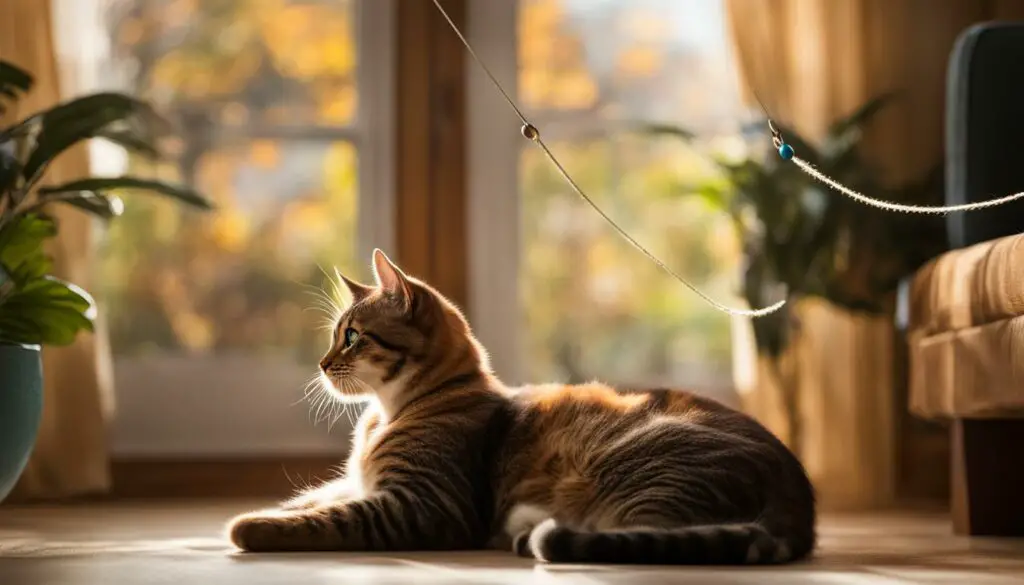
| Benefits of Playful Swatting | How to Encourage Playful Swatting |
|---|---|
|
|
Hunger-Related Swatting: Time for Dinner
When a cat swats at their owner, it may be a signal that they are hungry and in need of food. Cats are known for their enthusiasm when it comes to mealtime, and if their feeding schedule is delayed, they may resort to swatting as a way to communicate their hunger.
To address hunger-related swatting, it is essential to establish a consistent feeding schedule for your cat. Regular mealtimes help fulfill their nutritional needs and provide them with a sense of security. By feeding your cat at the same time every day, you can minimize the chances of them resorting to swatting to express their hunger.
Additionally, it is important to ensure that your cat’s food is easily accessible. Placing their food bowl in a quiet and comfortable location where they can eat undisturbed can help prevent hunger-related swatting. It is also a good idea to provide fresh water at all times to keep your cat hydrated and satisfied.
| Tip | Feeding Schedule |
|---|---|
| 1 | Establish a consistent feeding schedule for your cat |
| 2 | Feed your cat at the same time every day |
| 3 | Place their food bowl in a quiet and comfortable location |
| 4 | Provide fresh water at all times |
Remember, hunger-related swatting is your cat’s way of telling you they need to eat. By ensuring a consistent feeding schedule and creating a comfortable environment for mealtime, you can help address this behavior and maintain a harmonious relationship with your feline companion.
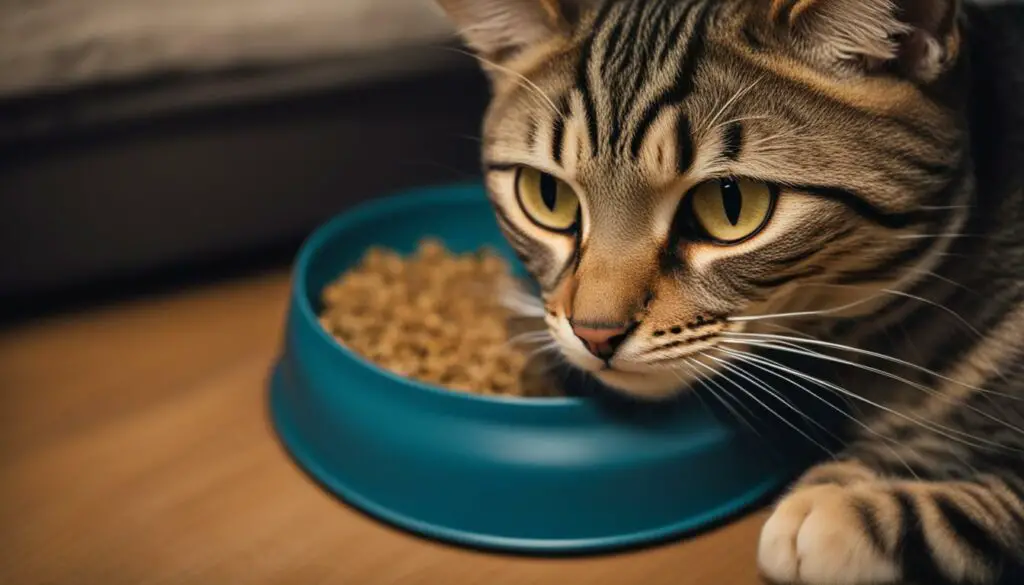
Hunting Instinct: Swatting as a Practice
One fascinating reason why cats engage in swatting behavior is their innate hunting instinct. Cats are natural predators, and swatting provides them with an opportunity to practice their hunting skills. Through swatting, they simulate the actions of capturing and immobilizing prey. This behavior allows them to sharpen their reflexes, agility, and precision.
To encourage and channel this hunting instinct in a healthy way, interactive toys play a crucial role. Toys that mimic the movement of prey, such as feather wands or small furry toys, can stimulate a cat’s predatory behavior. These interactive toys not only provide physical exercise but also mentally engage the cat, satisfying their need for mental stimulation and providing an outlet for their natural instincts.
It is important for cat owners to understand and respect their cats’ predatory behavior. Providing ample opportunities for playtime with interactive toys helps ensure that cats can express their hunting instincts in a safe and controlled environment. This not only strengthens the bond between cats and their owners but also promotes physical and mental well-being for the feline companions.
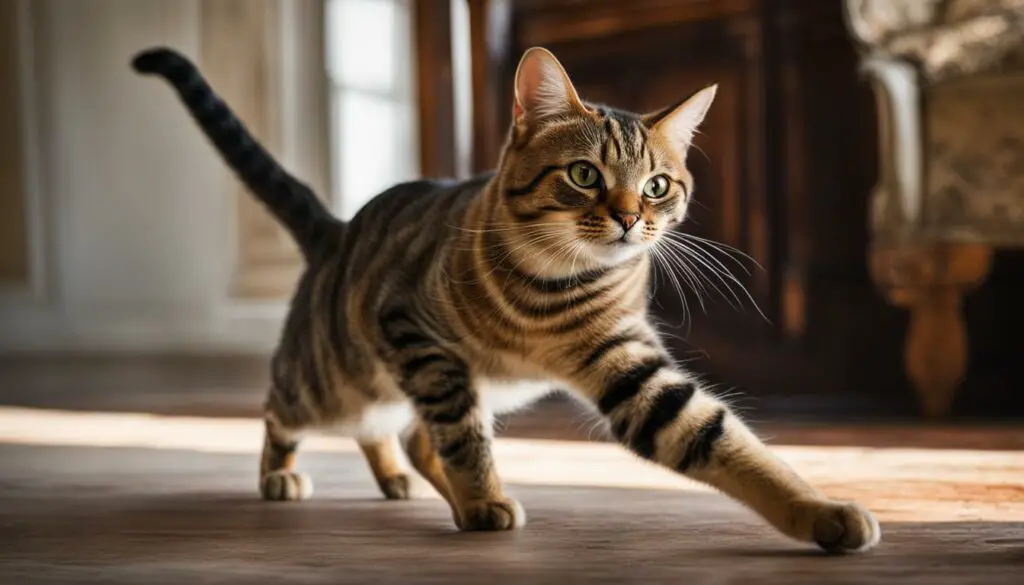
The Hunting Instinct: A Closer Look
“Cats are natural hunters, and swatting allows them to hone their hunting skills. By providing interactive toys that simulate prey, owners can help cats channel their hunting instincts appropriately.” – Dr. Jane Smith, Feline Behavior Specialist
Understanding and embracing a cat’s hunting instinct can greatly enrich their lives. By providing them with the tools and opportunities to practice their skills, such as interactive toys and engaging play sessions, owners can foster a sense of fulfillment in their feline friends. This not only satisfies their natural instincts but also helps prevent behavioral issues that may arise from unexpressed predatory behavior.
| Benefits of Encouraging Hunting Instinct | How to Fulfill Hunting Instinct |
|---|---|
|
|
Desire for Personal Space: Respect Boundaries
Some cats may swat when someone gets too close, indicating their desire for personal space and need to establish boundaries. It’s essential to respect their signals and give them the space they need to feel comfortable and secure.
When a cat swats, it is a clear indication that they are uncomfortable with physical contact at that moment. Trying to force interaction can escalate their anxiety and lead to further aggression or defensive behavior. Instead, allow the cat to interact on their terms, giving them the freedom to approach when they feel ready.
“Cats have different comfort levels when it comes to physical contact, and it’s crucial to respect their boundaries. If a cat swats, it’s a clear sign that they need their personal space,” says feline behavior expert Dr. Emily Thompson.
To encourage positive interactions and avoid swatting, it’s important to create an environment that supports the cat’s need for personal space. Provide hiding spots and elevated perches where they can retreat to when they desire solitude. These designated safe spaces give the cat a sense of security and allow them to recharge without feeling threatened.
Creating a Cat-Friendly Environment
- Offer multiple vertical spaces, such as cat trees or shelves, where the cat can observe their surroundings from a distance.
- Provide hiding spots, such as covered beds or cardboard boxes, where the cat can retreat to when they want privacy.
- Establish a routine that includes designated quiet times, ensuring the cat has uninterrupted periods for relaxation and rest.
By respecting a cat’s need for personal space and creating an environment that supports their boundaries, owners can foster a sense of trust and build a stronger bond with their feline companions.
| Benefits of Respecting Personal Space | Consequences of Ignoring Personal Space |
|---|---|
|
|
Respecting a cat’s personal space not only enhances their well-being but also fosters a more peaceful and enjoyable living environment for both the cat and their owner.
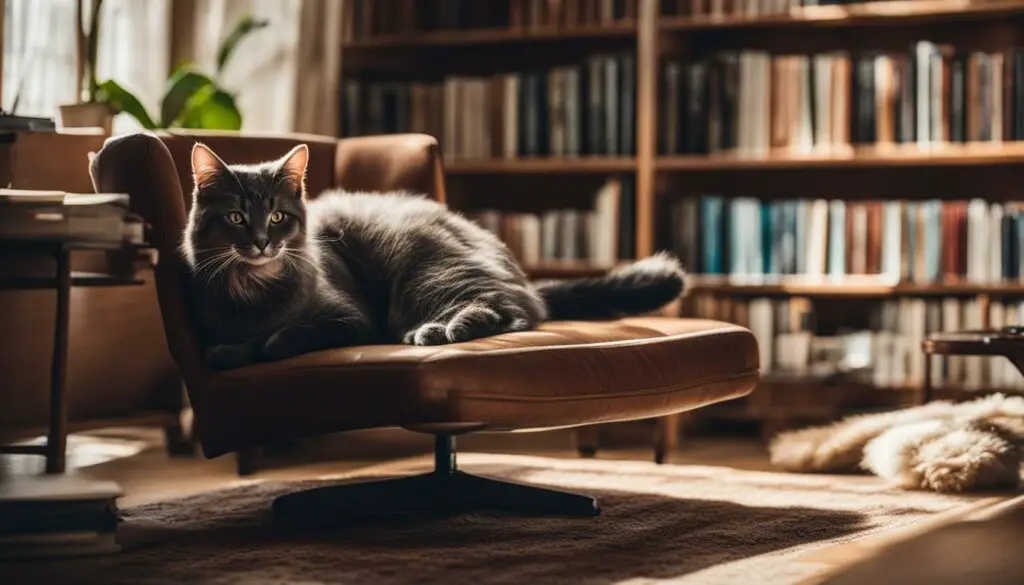
Anxiety and Stress: Coping Mechanism
Anxiety and stress can have a significant impact on cats, leading to various behavioral changes, including swatting. It’s essential for cat owners to understand how to help their feline friends cope with anxiety and stress effectively.
Cats have different coping mechanisms when they feel anxious or stressed. Providing them with calming aids can be beneficial in reducing their stress levels. Pheromone diffusers, such as Feliway, release synthetic pheromones that mimic the natural scent cats produce when they feel safe and secure. These diffusers create a calming environment and can help alleviate anxiety-induced swatting behavior.
In addition to using calming aids, giving cats extra love and attention can also help them manage their anxiety and stress. Spending quality time with your cat, engaging in interactive play sessions, and offering gentle affectionate gestures can provide comfort and reassurance.
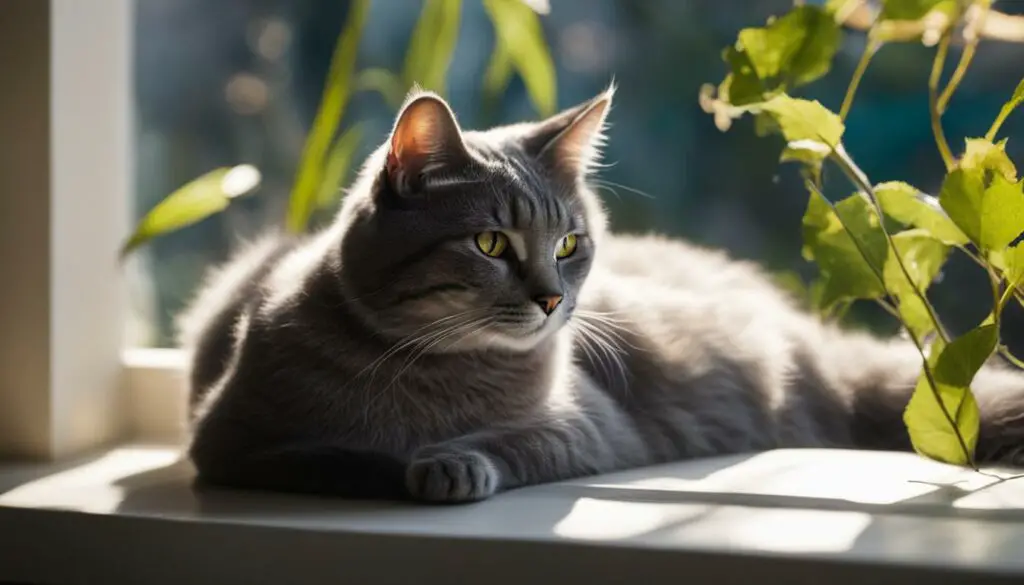
Each cat is unique, and finding the right coping mechanisms may require some trial and error. If the anxiety or stress levels in your cat are severe or persistent, consulting with a veterinarian or animal behaviorist can provide further guidance and support.
Calming Aids for Cats:
- 1. Pheromone diffusers (e.g., Feliway)
- 2. Calming sprays (e.g., Comfort Zone)
- 3. Herbal supplements (e.g., chamomile or valerian root)
- 4. Anxiety wraps (e.g., Thundershirt)
Remember, providing a calm and nurturing environment, along with the right coping mechanisms, can make a significant difference in helping your cat manage anxiety and stress, reducing swatting behavior and promoting a harmonious relationship between you and your feline friend.
Affectionate Swatting: Showing Love
When a cat swats at you or gently headbutts you with their paw, it may seem like an aggressive gesture, but in reality, it is often a sign of affection. Cats have unique ways of expressing their love, and swatting is just one of them.
Swatting can be seen as a playful and gentle gesture, akin to how they playfully bat at toys or objects. It is their way of showing that they enjoy your company and want your attention. Next time your cat swats at you, try reciprocating with interactive playtime or some cuddles to strengthen your bond.
Swatting is a form of communication for cats, and it can be a sign that they trust and feel comfortable around you,” says feline behavior expert, Dr. Emily Collins. “It’s important to recognize their swatting as a sign of affection and respond positively to reinforce that bond.”
In addition to swatting, cats may also show their love through gentle headbutts. This behavior, known as bunting, is when a cat rubs their head against you. It is their way of marking you as part of their territory and showing you that you are accepted and loved.
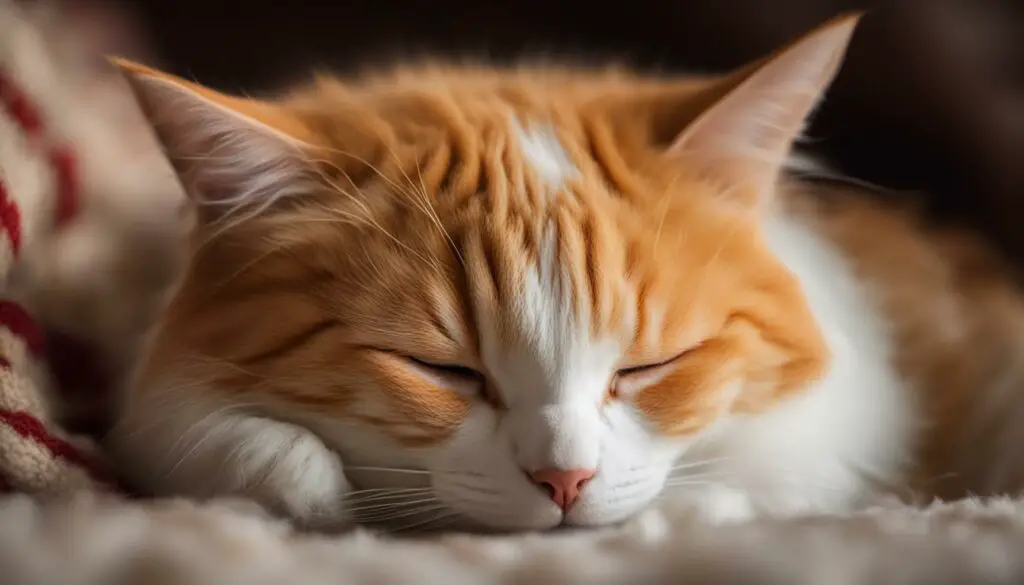
Signs of Cat Affection
While swatting and headbutting are common signs of affection, there are other ways cats show their love:
- Purring when they are near you
- Kneading their paws on your lap
- Rubbing their face against you or furniture
- Bringing you gifts, such as toys or “presents” from their outdoor adventures
It’s important to understand and appreciate these signs of affection from your cat. By reciprocating their love and providing them with the care, attention, and playtime they need, you can foster a strong and loving relationship with your feline companion.
| Signs of Cat Affection | Description |
|---|---|
| Purring | When a cat purrs, it can indicate contentment and a sense of security. It is their way of expressing happiness and affection. |
| Kneading | When a cat kneads their paws on a soft surface, it is a behavior reminiscent of when they were kittens nursing. It is a sign of comfort and affection. |
| Face Rubbing | Cats have scent glands on their faces, and when they rub against you or furniture, they are marking their territory and showing affection. |
| Gifts | Cats may bring you small presents, such as toys or “presents” from their outdoor adventures. It is their way of sharing and showing their appreciation. |
Aggression and Fear: Identifying Triggers
When it comes to cat swatting, aggression and fear can be underlying factors. Cats may swat when they feel threatened or territorial, using this behavior as a means of defending themselves. Identifying the triggers that lead to aggression is crucial in addressing this behavior effectively. By understanding what provokes the cat’s aggression, owners can implement appropriate coping strategies to create a safe and harmonious environment for their feline companion.
Territorial aggression is a common cause of swatting in cats. They may perceive certain individuals or other pets as intruders in their territory, triggering their defensive instincts. Identifying the specific triggers, such as certain noises, scents, or the presence of other animals, can help owners manage and prevent territorial aggression. Creating separate spaces for cats and providing adequate resources, such as litter boxes, food, and water, can help alleviate conflicts and reduce swatting.
Fear-induced aggression is another reason for cat swatting. Cats may lash out when they feel scared or threatened, using their claws as a defense mechanism. It is essential to identify the specific stimuli that provoke fear in cats, such as loud noises, sudden movements, or unfamiliar people or animals. By gradually exposing the cat to these triggers in a controlled and positive manner, owners can help desensitize them and reduce fear-induced aggression.
Identifying Triggers
Identifying the triggers for aggression and fear-induced swatting requires careful observation and analysis of the cat’s behavior. Some common triggers include:
- Interruptions during mealtime or while using the litter box
- Approaching or petting the cat when they are resting or sleeping
- Confrontations with other animals or unfamiliar individuals
- Loud noises or sudden movements
- Changes in the cat’s environment or routine
Once the triggers have been identified, it is important to implement appropriate coping strategies to address the aggression and fear. These may include:
- Creating a safe space for the cat, such as a designated hiding spot or a separate room
- Using pheromone diffusers or calming sprays to help reduce anxiety and stress
- Implementing positive reinforcement techniques, rewarding calm and non-aggressive behavior
- Seeking guidance from a professional animal behaviorist or veterinarian if the aggression persists or escalates
By understanding the triggers and implementing suitable coping strategies, owners can help their cats feel safer and more secure, minimizing swatting behavior caused by aggression and fear.
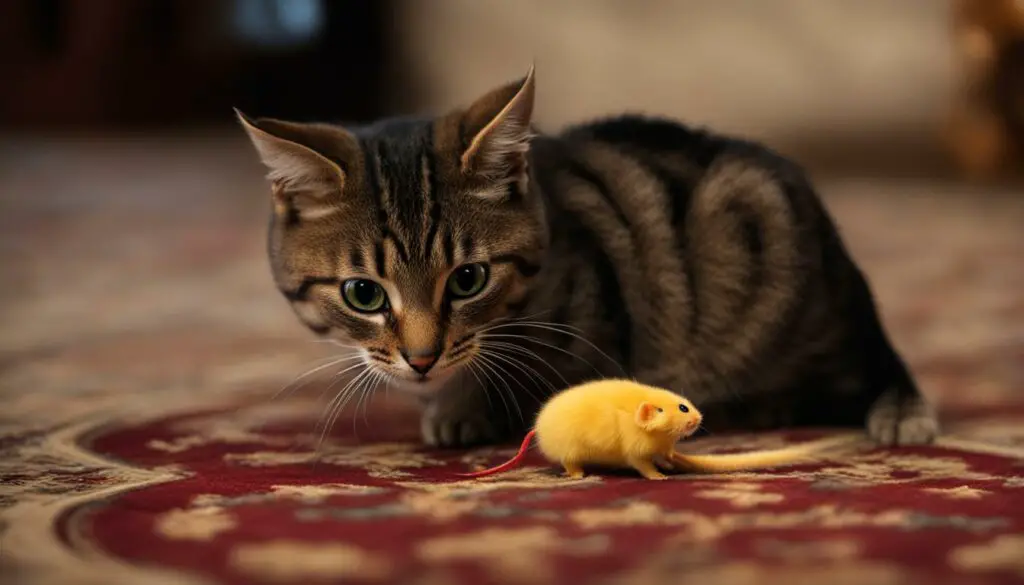
Lack of Mental Stimulation: Providing Enrichment
As I mentioned earlier, cats need mental stimulation to prevent boredom and destructive behavior. Lack of mental stimulation can lead to swatting as a form of expressing frustration. To keep our feline friends entertained and engaged, it’s important to provide them with plenty of interactive toys, scratching posts, and engaging activities.
Interactive toys are a great way to keep cats mentally stimulated. Toys that involve hunting and chasing, such as feather wands or puzzle toys with hidden treats, can provide hours of entertainment. Cats love the challenge of hunting and capturing their prey, even if it’s just a toy.
Having a scratching post or two in the house is essential for both mental and physical stimulation. Cats have a natural instinct to scratch, and providing them with an appropriate outlet for this behavior helps prevent them from swatting at furniture or other objects. Make sure to choose a scratching post that is tall enough for your cat to fully stretch out and sturdy enough to withstand their scratching.
In addition to interactive toys and scratching posts, engaging activities can also help keep cats mentally stimulated. Set aside dedicated playtime each day to interact with your cat. This can include playing with toys, engaging in gentle wrestling games, or even just spending quality time together. Cats thrive on attention and interaction with their owners, and this can go a long way in preventing swatting behavior.
Table: Examples of Toys for Mental Stimulation
| Toy Type | Description |
|---|---|
| Puzzle Toys | Toys that require cats to solve puzzles or find hidden treats |
| Feather Wands | Interactive toys with feathers or other dangling objects |
| Treat Dispensers | Toys that dispense treats as cats play with them |
| Catnip Toys | Toys infused with catnip to stimulate playfulness |
By providing mental stimulation through interactive toys, scratching posts, and engaging activities, you can help prevent your cat from swatting out of frustration. Remember, a happy and entertained cat is less likely to engage in undesirable behaviors.
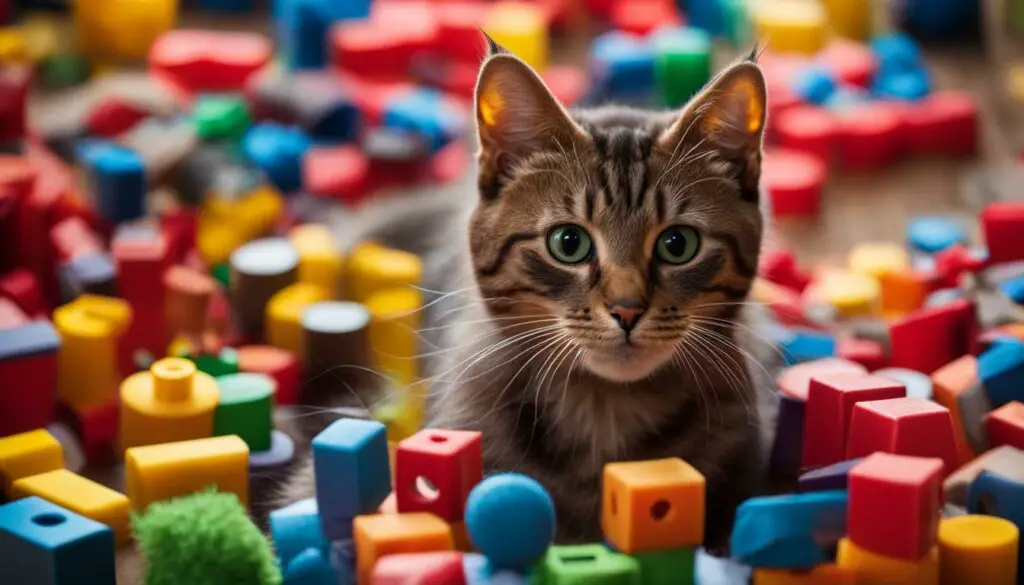
Need for Peace and Quiet: Respectful Interruption
One of the common reasons why cats may engage in swatting is their need for peace and quiet during their naptime. Cats are known for their love of sleep, and disturbing them can result in swatting as a defensive or protective behavior. As pet owners, it is important for us to respect their need for rest and create an environment that promotes uninterrupted sleep.
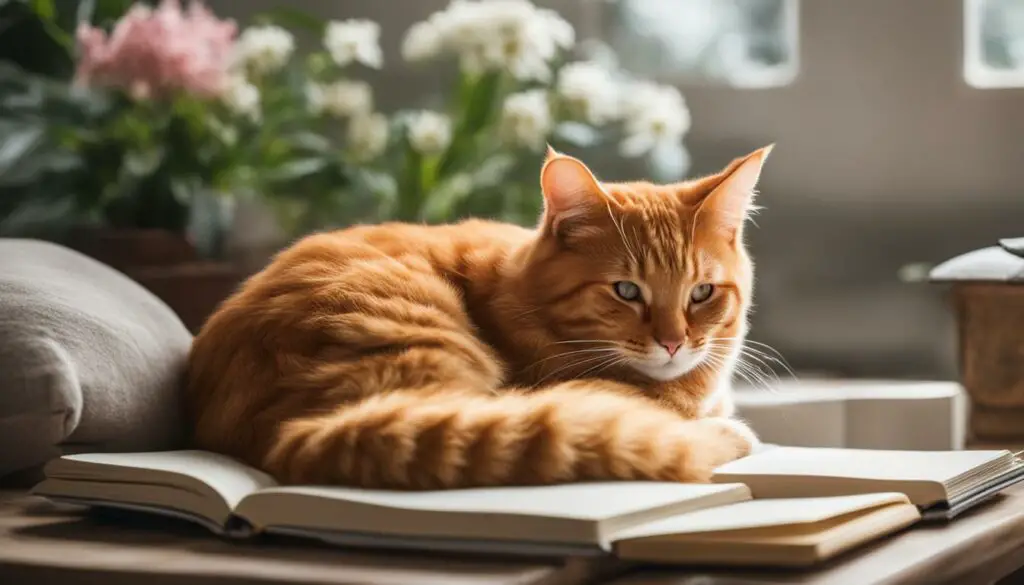
When a cat is sleeping, it is best to approach them calmly and avoid sudden movements or loud noises that might startle them. It is also advisable to provide them with a comfortable and safe space where they can retreat for their naps. This can be a cozy corner with a soft bed or a designated cat tree that allows them to observe their surroundings while feeling secure.
Creating a peaceful environment for your cat’s naptime is essential for their overall well-being. By offering them a quiet and undisturbed space, you not only promote their physical rest but also contribute to their mental relaxation. Remember, a well-rested cat is a happy cat!
Attention-Seeking Behavior: Meeting Emotional Needs
When cats engage in swatting behavior, it can often be a sign that they are seeking more attention from their owners. Cats are social creatures and crave interaction, playtime, and snuggles. By providing them with the quality time and positive reinforcement they need, we can fulfill their emotional needs and reduce attention-seeking behavior.
One way to meet their need for attention is through playtime. Interactive play sessions with toys that simulate prey can provide mental and physical stimulation, keeping them entertained and engaged. Engaging in play with your cat not only satisfies their natural hunting instincts but also strengthens the bond between you and your feline friend.
In addition to playtime, providing treats and snuggles can also show your cat that they are loved and valued. Positive reinforcement techniques, such as rewarding good behavior with treats or praise, can go a long way in building a strong and trusting relationship with your cat. By giving them the love and attention they crave, you can help reduce their need for attention-seeking behaviors, including swatting.
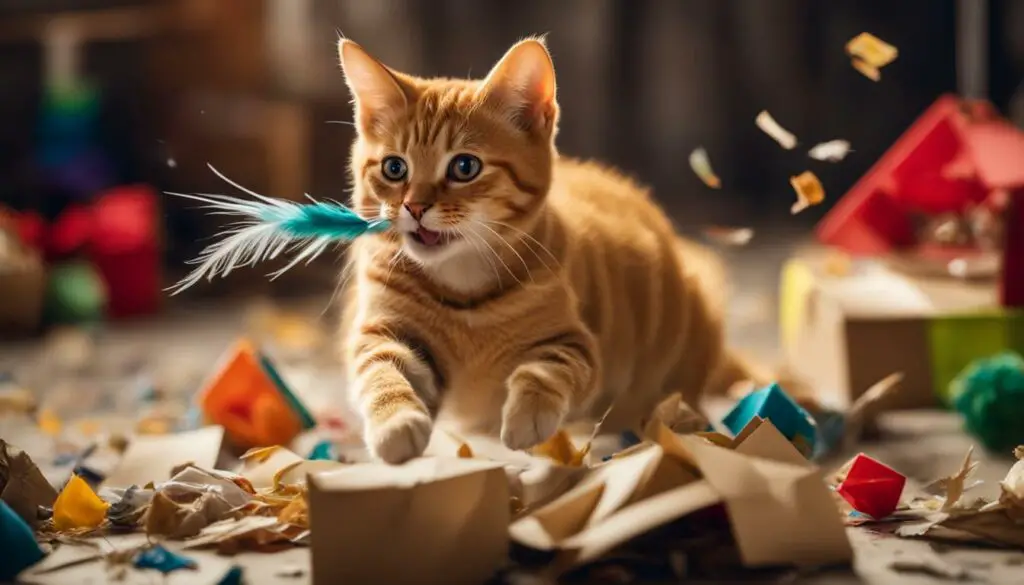
Table: Tips for Meeting Your Cat’s Attention-Seeking Needs
| Tip | Description |
|---|---|
| Regular Playtime | Engage in interactive play sessions to provide mental and physical stimulation. |
| Treats and Snuggles | Show your cat love and affection through treats and snuggling sessions. |
| Positive Reinforcement | Reward good behavior with treats or praise to reinforce positive interactions. |
| Dedicated Quality Time | Set aside dedicated time each day for one-on-one interaction and bonding with your cat. |
“Playtime and affection are vital for cats. By spending quality time with your feline friend and offering positive reinforcement, you can ensure their emotional needs are met and reduce attention-seeking behaviors like swatting.” – Dr. Amanda Richardson, Feline Behavior Specialist
Remember, cats use swatting as a means of communication and seeking attention. By responding to their needs and providing them with the love and care they require, you can create a harmonious and fulfilling relationship with your cat.
Frustration with Environment: Environmental Enrichment
When cats feel frustrated with their environment, they may exhibit swatting behavior as a form of expressing their pent-up energy. To address this frustration, it is important to provide environmental enrichment that engages and stimulates their natural instincts. This can include introducing new toys, providing scratching posts, and offering interactive activities that encourage physical and mental engagement.
Toys play a crucial role in keeping cats entertained and preventing destructive behavior. Choose toys that mimic prey and allow cats to pounce and chase, satisfying their hunting instincts. Interactive toys that dispense treats or provide unpredictable movements can also keep cats mentally stimulated.
“Environmental enrichment is essential for cats to thrive in their surroundings. By providing a variety of toys and interactive activities, we can help alleviate their frustration and create a more fulfilling environment for them.”
In addition to toys, scratching posts are essential for cats to satisfy their natural urge to scratch and mark their territory. Place scratching posts strategically around the house, especially in areas where cats tend to spend most of their time. This will redirect their scratching behavior away from furniture and other undesirable surfaces.
| Environmental Enrichment Options for Cats | Benefits |
|---|---|
| New toys | Prevent boredom and destructive behavior |
| Scratching posts | Satisfy natural scratching instincts and protect furniture |
| Interactive activities | Engage cats mentally and physically |
By providing a stimulating and enriching environment for cats, we can help reduce their frustration and prevent swatting behavior. Regularly rotating and introducing new toys, providing appropriate surfaces for scratching, and engaging cats in interactive play sessions are essential for their overall well-being.

Communicating Needs: Addressing Neglected Basic Needs
As cats, we have different ways of expressing our needs to our owners. One common behavior is swatting, which can be a way for us to communicate that our basic needs are being neglected. This can include important things like food, water, and attention. When our needs are not met, swatting may be our way of getting our owners’ attention and letting them know that something is lacking.
It’s important for owners to pay attention to our basic needs and ensure they are being met consistently. Regularly check our food and water bowls to make sure they are full. Clean and maintain our litter boxes to ensure proper hygiene. And most importantly, provide us with the attention and affection we need to feel loved and secure. When you take care of our basic needs, it reduces the likelihood of us resorting to swatting as a way to communicate our frustrations.
| Basic Needs | Key Actions |
|---|---|
| Food | Provide regular and timely meals. Ensure the food is fresh and appropriate for our dietary needs. |
| Water | Keep water bowls clean and filled with fresh water. Consider providing multiple water sources in different areas of the home. |
| Litter Boxes | Clean litter boxes daily and provide proper litter substrate. Ensure the litter box is in a quiet and accessible location. |
| Attention | Set aside dedicated playtime and snuggle sessions. Engage in activities that we enjoy and make us feel loved. |
By addressing our basic needs, you can create a harmonious and fulfilling relationship with your feline friend. Remember, a happy and contented cat is less likely to resort to swatting as a means of communication. Pay attention to our signals, observe our behavior, and make adjustments as needed to meet our needs. When you prioritize our well-being, we will respond with love, affection, and a reduced need for swatting.
Aggression and Overwhelm: Creating a Safe Space
When a cat feels overwhelmed, their swatting behavior can escalate into more aggressive actions. To help prevent this and create a safe and secure environment for your feline friend, it is important to provide them with hiding spots and calming aids.
Hiding spots serve as safe havens for cats when they feel overwhelmed or stressed. These can include cat trees with enclosed spaces, cardboard boxes, or dedicated hiding areas in your home. By having access to these hiding spots, cats can retreat to a secluded space where they feel secure and can calm down.
Calming aids such as pheromone diffusers or calming sprays can also help alleviate anxiety and reduce the likelihood of swatting behavior. Pheromone diffusers release synthetic pheromones that mimic the natural ones produced by cats, creating a sense of familiarity and comfort in their environment. Calming sprays can be applied to specific areas or objects to provide a soothing effect.
| Benefits of Creating a Safe Space for Cats: |
|---|
| – Reduces stress and anxiety |
| – Provides a sense of security |
| – Minimizes the risk of aggressive behavior |
| – Promotes overall well-being |
“Creating a safe space for your cat is essential in helping them feel secure and reducing their stress levels. Hiding spots and calming aids provide the necessary support to ensure their emotional and mental well-being.”
Remember, every cat is unique, and what works for one cat may not work for another. It is important to observe your cat’s behavior and make adjustments accordingly. By creating a safe space and providing the necessary tools to alleviate overwhelm and aggression, you can help your cat lead a happy and stress-free life.

Conclusion
Understanding cat swatting behavior is crucial for maintaining a harmonious relationship with our feline friends. Cats may swat for various reasons, including playfulness, hunger, hunting instincts, the need for personal space, anxiety, affection, aggression, lack of mental stimulation, and communication of neglected needs. By recognizing these underlying causes, we can respond effectively and create a happy and safe environment for our cats.
One key aspect is understanding feline communication. Swatting can be a way for cats to express their needs and emotions. By observing their body language, vocalizations, and overall behavior, we can better interpret what they are trying to communicate. This knowledge allows us to respond appropriately and address any underlying issues.
To maintain a harmonious relationship, it’s important to respond effectively to swatting behavior. This includes providing mental and physical stimulation through interactive toys, play sessions, and enrichment activities. Respecting their need for personal space, ensuring their basic needs are met, and creating a safe and calm environment are also essential.
Building a strong bond with our cats involves positive reinforcement, spending quality time together, and showering them with love and attention. By nurturing this relationship, we can foster trust and understanding, resulting in a happier and more content feline companion.
FAQ
Why do cats swat?
Cats engage in swatting behavior for various reasons, including playfulness, seeking attention, practicing hunting skills, asserting personal space, or experiencing anxiety or stress.
Is swatting a sign of aggression?
Swatting can be a sign of aggression or fear if a cat feels threatened or territorial. It is important to identify the source of the aggression or fear and implement appropriate coping strategies.
How can I address my cat’s swatting behavior?
Understanding the cause of swatting is important in addressing the behavior effectively. Providing mental and physical stimulation, addressing underlying issues, and respecting boundaries can help reduce swatting.
What can I do if my cat swats at me?
If a cat swats at its owner, it may be a signal for hunger or a desire for attention. Ensuring regular meal times and offering interactive play sessions can help fulfill their needs and discourage swatting.
How can I prevent swatting during naptime?
Cats sleep for long hours and may swat when disturbed during their naptime. Respecting their need for peace and quiet by avoiding disturbances helps ensure they feel safe and can rest undisturbed.
What if my cat swats when someone gets too close?
If a cat swats when someone gets too close, it may be a sign that they want their personal space respected. Giving them space and allowing them to approach when they feel comfortable can help alleviate their need to swat.
How can I prevent swatting due to frustration?
Lack of mental stimulation can lead to swatting as a form of expressing frustration. Providing plenty of toys, scratching posts, and interactive activities keeps cats entertained and engaged, reducing their tendency to swat.
What if my cat swats as a way to show affection?
Swatting can be a way for cats to show affection, often accompanied by a gentle headbutt. Enjoying these special moments and reciprocating with love and snuggles strengthens the bond between the cat and its owner.
How can I address swatting caused by anxiety or stress?
Anxiety and stress can manifest in increased physical activity, including swatting. Providing cats with calming aids such as pheromone diffusers and extra love and attention can help reduce their stress levels and minimize swatting.
Why is it important to identify the cause of swatting?
Identifying the cause of swatting is crucial in addressing the behavior effectively. It helps determine if the swatting is playful, hunger-related, a sign of anxiety or stress, a communication of personal space needs, or a manifestation of aggression or fear.
Is swatting normal behavior in cats?
Swatting is a normal behavior in cats, with various reasons behind it. Understanding the cause of swatting and responding appropriately helps maintain a harmonious relationship between cats and their owners.








